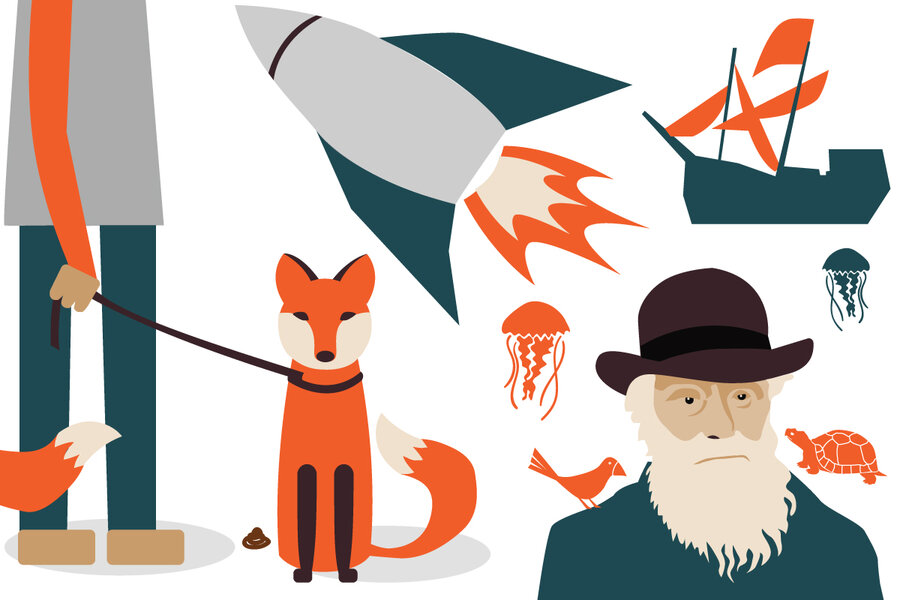From rockets to cuddly foxes, kids books that inspire scientific curiosity
Children are born curious about the world, and there are few better ways to stoke their curiosity than with a good book.
Science books in particular have a way of opening new vistas, not just with the topics they reveal, but also in the ways they teach the scientific method. Over the past four centuries, that creative yet logical mode of thought has radically transformed every aspect of human existence.
OK, but which books to get? For this list, we’ve selected our favorite books published in the past three years for each age range. We aimed for books that include not just facts about the natural world but also stories that convey how scientists think about it.
Infant
Canadian physicist Chris Ferrie has written a series of two dozen or so Baby University board books with tongue-in-cheek distillations of complex scientific topics into simple words and pictures. “Rocket Science for Babies” covers the basics of aerodynamic lift and Newton’s third law. “General Relativity for Babies” discusses the relationship between mass and space-time. And “Quantum Physics for Babies” explains the quantum discontinuity. Your baby almost certainly won’t learn any science from these books, but if you’ve never taken a college-level physics class, you probably will.
Pre-K to kindergarten
How does an animal go from being wild to being domesticated? A breeding experiment in Siberia, now in its sixth decade, aims to answer this question by transforming wild silver foxes into domestic canines. Written by University of Louisville biologist Lee Dugatkin and Russian geneticist Lyudmila Trut, the experiment’s lead researcher, “Pushinka the Barking Fox: A True Story of Unexpected Friendship” presents young children with a gentler view of evolution, one that proceeds not through struggle and competition, but through affection and cooperation. “Love,” write the authors, “changes us.”
First to second grade
The relentlessly inquisitive Ada Marie Twist, the star of the 2016 children’s book “Ada Twist, Scientist,” is back with a roster of science experiments to conduct at home. With “Ada Twist’s Big Project Book for Stellar Scientists” by Andrea Beaty, readers can learn why the moon seems to change shape, how plants decompose, and what steps we can take to limit greenhouse gas emissions. More importantly, readers will learn how scientists think, and about the difference between facts and feelings.
Second to third grade
Rocketry enthusiasts who are too young for Margot Lee Shetterly’s book “Hidden Figures,” or the 2016 movie of the same name, should check out “Counting on Katherine,” Helaine Becker’s biography of Katherine Johnson, the African American mathematician whose calculations proved essential to the success of NASA’s Mercury and Apollo missions. Illustrated by Dow Phumiruk, “Counting on Katherine” will take you from the early 1920s, showing Katherine as a young prodigy counting the steps up to church, to the 1970s, when her hurried calculations of orbital trajectories helped save the crew of Apollo 13.
Fourth to sixth grade
Dog lovers, or really anyone interested in how animals think, will enjoy “Inside of a Dog – Young Readers Edition” by Barnard psychologist Alexandra Horowitz. This 2016 adaptation of Horowitz’s 2009 bestseller, rewritten in simple yet lively prose for kids ages 8-12, examines the canine umwelt – the world as experienced “from the dog’s point of nose.”
Middle school
Anyone studying the life sciences is best advised to begin with Charles Darwin. But young readers might face some challenges when reading the British naturalist for the first time. One, of course, is the casual racism and sexism typical of Victorian writers. The other is that Darwin uses lots of examples to make his case for evolution by way of mutation and natural selection. Adapted by Rebecca Stefoff and lavishly illustrated, “On the Origin of Species: Young Readers Edition” avoids these pitfalls, offering a tween-friendly version of Darwin that doesn’t get bogged down in detail yet is still more or less straight from the horse’s mouth (or finch’s beak).
High school
Randall Munroe’s minimalist 2005 web comic “xkcd” has gained a cult following for its unapologetically nerdy humor. In “How To: Absurd Scientific Advice for Common Real-World Problems,” he takes ordinary problems – how to move, how to fill a swimming pool, how to make friends – and uses them to create the most extreme scenarios. For instance, Munroe calculates that you could transport your entire house using two Boeing 787 engines, although he cautions that you’d probably want to add a third or a fourth for stability. “How To” also includes advice from Canadian astronaut Chris Hadfield, who flew two NASA missions, on how to land the space shuttle in an emergency, and from Serena Williams on how to take down a drone with a tennis ball.






